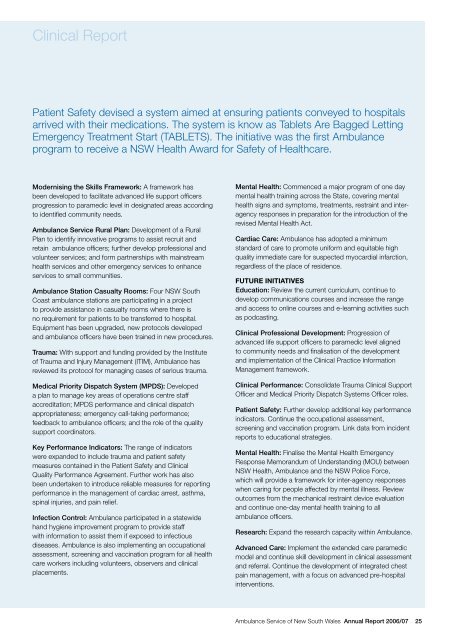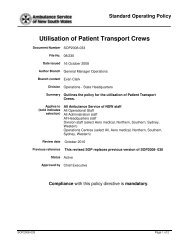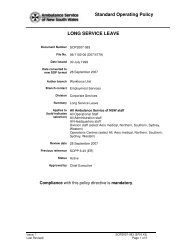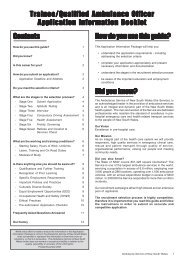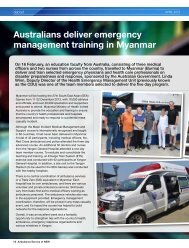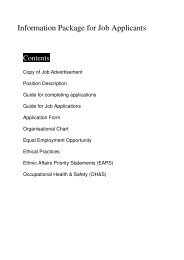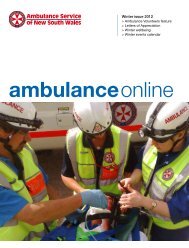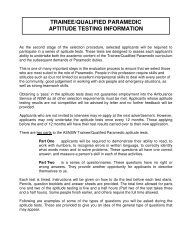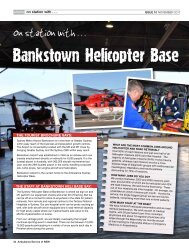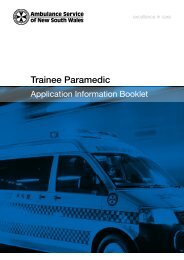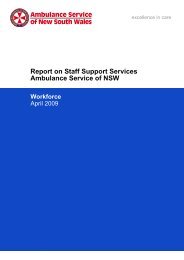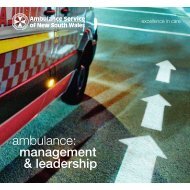Annual Report - Ambulance Service of NSW
Annual Report - Ambulance Service of NSW
Annual Report - Ambulance Service of NSW
You also want an ePaper? Increase the reach of your titles
YUMPU automatically turns print PDFs into web optimized ePapers that Google loves.
Clinical <strong>Report</strong>Patient Safety devised a system aimed at ensuring patients conveyed to hospitalsarrived with their medications. The system is know as Tablets Are Bagged LettingEmergency Treatment Start (TABLETS). The initiative was the first <strong>Ambulance</strong>program to receive a <strong>NSW</strong> Health Award for Safety <strong>of</strong> Healthcare.Modernising the Skills Framework: A framework hasbeen developed to facilitate advanced life support <strong>of</strong>ficersprogression to paramedic level in designated areas accordingto identified community needs.<strong>Ambulance</strong> <strong>Service</strong> Rural Plan: Development <strong>of</strong> a RuralPlan to identify innovative programs to assist recruit andretain ambulance <strong>of</strong>ficers; further develop pr<strong>of</strong>essional andvolunteer services; and form partnerships with mainstreamhealth services and other emergency services to enhanceservices to small communities.<strong>Ambulance</strong> Station Casualty Rooms: Four <strong>NSW</strong> SouthCoast ambulance stations are participating in a projectto provide assistance in casualty rooms where there isno requirement for patients to be transferred to hospital.Equipment has been upgraded, new protocols developedand ambulance <strong>of</strong>ficers have been trained in new procedures.Trauma: With support and funding provided by the Institute<strong>of</strong> Trauma and Injury Management (ITIM), <strong>Ambulance</strong> hasreviewed its protocol for managing cases <strong>of</strong> serious trauma.Medical Priority Dispatch System (MPDS): Developeda plan to manage key areas <strong>of</strong> operations centre staffaccreditation; MPDS performance and clinical dispatchappropriateness; emergency call-taking performance;feedback to ambulance <strong>of</strong>ficers; and the role <strong>of</strong> the qualitysupport coordinators.Key Performance Indicators: The range <strong>of</strong> indicatorswere expanded to include trauma and patient safetymeasures contained in the Patient Safety and ClinicalQuality Performance Agreement. Further work has alsobeen undertaken to introduce reliable measures for reportingperformance in the management <strong>of</strong> cardiac arrest, asthma,spinal injuries, and pain relief.Infection Control: <strong>Ambulance</strong> participated in a statewidehand hygiene improvement program to provide staffwith information to assist them if exposed to infectiousdiseases. <strong>Ambulance</strong> is also implementing an occupationalassessment, screening and vaccination program for all healthcare workers including volunteers, observers and clinicalplacements.Mental Health: Commenced a major program <strong>of</strong> one daymental health training across the State, covering mentalhealth signs and symptoms, treatments, restraint and interagencyresponses in preparation for the introduction <strong>of</strong> therevised Mental Health Act.Cardiac Care: <strong>Ambulance</strong> has adopted a minimumstandard <strong>of</strong> care to promote uniform and equitable highquality immediate care for suspected myocardial infarction,regardless <strong>of</strong> the place <strong>of</strong> residence.FUTURE INITIATIVESEducation: Review the current curriculum, continue todevelop communications courses and increase the rangeand access to online courses and e-learning activities suchas podcasting.Clinical Pr<strong>of</strong>essional Development: Progression <strong>of</strong>advanced life support <strong>of</strong>ficers to paramedic level alignedto community needs and finalisation <strong>of</strong> the developmentand implementation <strong>of</strong> the Clinical Practice InformationManagement framework.Clinical Performance: Consolidate Trauma Clinical SupportOfficer and Medical Priority Dispatch Systems Officer roles.Patient Safety: Further develop additional key performanceindicators. Continue the occupational assessment,screening and vaccination program. Link data from incidentreports to educational strategies.Mental Health: Finalise the Mental Health EmergencyResponse Memorandum <strong>of</strong> Understanding (MOU) between<strong>NSW</strong> Health, <strong>Ambulance</strong> and the <strong>NSW</strong> Police Force,which will provide a framework for inter-agency responseswhen caring for people affected by mental illness. Reviewoutcomes from the mechanical restraint device evaluationand continue one-day mental health training to allambulance <strong>of</strong>ficers.Research: Expand the research capacity within <strong>Ambulance</strong>.Advanced Care: Implement the extended care paramedicmodel and continue skill development in clinical assessmentand referral. Continue the development <strong>of</strong> integrated chestpain management, with a focus on advanced pre-hospitalinterventions.<strong>Ambulance</strong> <strong>Service</strong> <strong>of</strong> New South Wales <strong>Annual</strong> <strong>Report</strong> 2006/07 25


